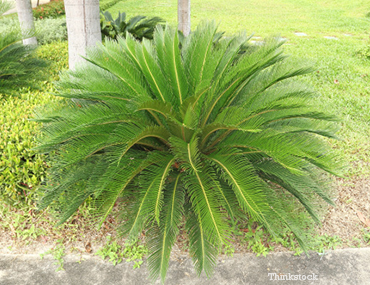
There are a lot of poisonous plants out there, but few cause fatalities in dogs. Today, I wanted to write about the dangers of the sago palm, because people are often unaware of this potentially deadly plant.
Sago Palms are members of the Order Cycadacae; genera Cycads, Macrozamia, and Zamias.1 Their family includes the following plants:
- Cycad (Cycas cirinalis)
- Coontie plant (Zamia pumila)
- Japanese cycad (Cycad revoluta)
- Cardboard palm (Zamia furfuracea)
All parts of sago palms are poisonous – especially the seeds, which contain large amounts of the poison cycasin. It only takes a tiny amount to result in poisoning of dogs; as little as 2 seeds.
The Sago palm typically grows in warm, temperate environments – including the Southern United States and Hawaii. It’s often found growing outside in yards as an ornamental plant. Recently, veterinarians have been seeing an increase in dogs poisoned by sago palm; that’s because this plant is now readily available everywhere as an ornamental Bonsai houseplant.
When dogs get into sago palm, it affects three main organ systems: the GIT, liver, and central nervous system (CNS). Signs of poisoning can be seen within 15 minutes or up to several hours after ingestion, but blood work changes from liver failure may not show for days.
Clinical signs or physical examination findings seen with sago palm poisoning in dogs include the following:

- Lethargy
- Inappetance
- Vomiting (which may be bloody)
- Diarrhea (which may be bloody or black and tarry)
- Dehydration
- Abominal pain
- Jaundiced gums
- Ataxia
- Tremors
- Seizures
- Coma
- Death
Unfortunately, the survival rate for sago palm poisoning in dogs ranges from 32-50%,2,3 and long-term recovery could be further complicated by the development of chronic liver disease. As a result, if your dog got into sago palm, call your veterinarian or emergency veterinarian right away and seek immediate veterinary attention (yes, even in the middle of the night). With any poisoning, the sooner you seek attention, the better the prognosis and the less costly or damaging to you and your pet.
If you have any questions or concerns, you should always visit or call your veterinarian – they are your best resource to ensure the health and well-being of your pets.
References:
- Klatt CA. Sago Palm. In: Osweiler G, Hovda L, Brutlag A, Lee JA, eds. Blackwell’s Five-Minute Veterinary Consult Clinical Companion: Small Animal Toxicology, 1st Ed. Iowa City: Wiley-Blackwell, 2010, pp. 743-741.
- Albertson JC, Khan S, Richardson J. Cycad palm toxicosis in dogs: 60 cases (1987-1997). J Amer Vet Med Assoc 1998; 213:99-101.
- Ferguson D, Crowe M, McLaughlin L, et al. Survival and prognostic indicators for cycad intoxication in dogs. J Vet Inter Med 2011;25:831-837.
